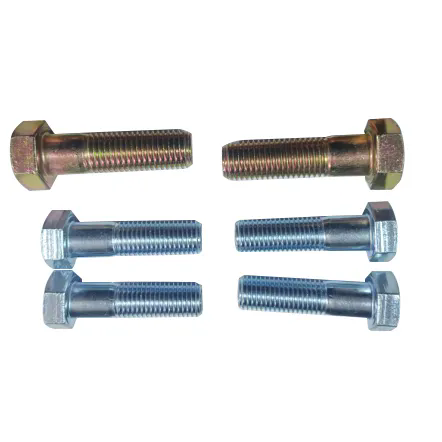A Comprehensive Guide to DIN931 Hex Bolts: Uses, Benefits, and Specifications
2024-10-18
DIN931 hex bolts are a popular type of fastener widely used in machinery, construction, automotive industries, and engineering applications. Known for their durability and precision, these bolts feature a hexagonal head and a partially threaded shank, making them ideal for securing structural components that require a reliable and reusable fastening solution.
In this blog, we’ll dive into the features, applications, and benefits of DIN931 hex bolts, as well as tips on selecting the right bolts for your project.
What Are DIN931 Hex Bolts?
DIN931 refers to a German standard for hexagon head bolts that defines specific dimensions, tolerances, and material properties. These bolts typically have coarse threads and are partially threaded along the shank, which gives them high tensile strength and makes them suitable for heavy-duty fastening applications.
Key characteristics include:
- Hexagonal head for easy tightening with a wrench or spanner.
- Partially threaded shank (unlike DIN933 bolts, which are fully threaded).
- Made from various materials such as carbon steel, stainless steel, or zinc-coated steel for corrosion resistance.
Specifications and Standards
- Size Range: Typically from M5 to M64 in metric sizes.
- Thread Pitch: Coarse threads for general applications; fine-thread versions are available for specialized use.
- Material Grades:
- Grade 8.8: High-tensile steel for heavy-load applications.
- Grade 10.9 and 12.9: Stronger bolts for demanding environments.
- A2 and A4 Stainless Steel: Corrosion-resistant options for marine and outdoor use.
- Surface Finishes: Zinc-plated, hot-dip galvanized, or black-oxide finish for enhanced durability.
Common Applications of DIN931 Hex Bolts
1. Construction and Infrastructure
- Used in structural frameworks, bridges, and buildings to ensure secure assembly.
- Ideal for steel-to-steel connections due to their high strength.
2. Machinery and Equipment
- Found in industrial machines and assembly lines, providing secure fastening of heavy components.
- The partially threaded design reduces stress concentration, improving joint reliability.
3. Automotive Industry
- Used in engine components, suspensions, and chassis systems where durability is critical.
- Their precision threading ensures a tight fit in high-vibration environments.
4. Marine and Outdoor Applications
- Stainless steel DIN931 bolts (A2 or A4) offer corrosion resistance, making them suitable for marine environments or outdoor structures.
Benefits of Using DIN931 Hex Bolts
1. High Tensile Strength
- These bolts are ideal for high-load applications where strength and durability are essential.
2. Ease of Installation and Removal
- The hexagonal head allows easy tightening or loosening using standard wrenches or spanners.
3. Reusability
- DIN931 hex bolts are reusable, making them a cost-effective solution for assemblies that require disassembly and reassembly.
4. Versatility
- Available in a variety of sizes, finishes, and materials, these bolts can meet the needs of different industries and environmental conditions.
5. Corrosion Resistance
- Stainless steel and zinc-coated versions provide protection against rust and corrosion, making them ideal for long-term outdoor use.
How to Choose the Right DIN931 Hex Bolts
1. Determine Load Requirements
- Select the appropriate material grade (e.g., 8.8, 10.9) based on the weight and stress the bolt will handle.
2. Match the Environment
- Use stainless steel or galvanized bolts for outdoor or corrosive environments.
- For indoor or dry environments, standard steel with a black-oxide finish may suffice.
3. Select the Correct Size and Length
- Choose a bolt length that leaves sufficient shank exposed for better load distribution.
4. Ensure Compatibility with Nuts and Washers
- Use matching DIN nuts and washers to ensure a secure fit and prevent loosening over time.
5. Check Standards and Certification
- Ensure the bolts meet DIN931 standards and any additional industry-specific requirements (e.g., ISO or ANSI).
Tips for Proper Installation
- Use Lock Washers: Prevent bolts from loosening in high-vibration settings by using spring washers or nylon-insert nuts.
- Apply Torque Properly: Use a torque wrench to apply the correct amount of force and avoid overtightening.
- Lubricate Threads: For easier installation and rust prevention, consider applying a small amount of thread lubricant.
- Inspect Regularly: Periodically check for wear, rust, or signs of loosening, especially in outdoor or mechanical applications.
Maintenance and Care of DIN931 Hex Bolts
1. Inspect for Corrosion and Wear
- Regularly check bolts exposed to moisture or chemicals for signs of corrosion.
2. Retighten When Necessary
- For dynamic applications, such as engines or machinery, inspect and retighten bolts periodically to maintain secure connections.
3. Replace Worn Bolts Promptly
- Replace any bolts showing signs of deformation or cracking to ensure safety and reliability.
4. Store Properly
- Keep unused bolts in a dry, organized space to prevent rust and make future use easy.
Conclusion: The Versatile Fastening Solution for Heavy-Duty Applications
DIN931 hex bolts are a trusted fastening solution across many industries, known for their strength, durability, and versatility. Whether you're working on a building project, assembling machinery, or maintaining automotive components, these bolts deliver reliable performance in even the most demanding environments.
By selecting the right material, size, and finish, and following best installation practices, DIN931 hex bolts can enhance the safety and longevity of your assemblies. Invest in high-quality DIN931 bolts today for dependable fastening solutions that stand the test of time.
Looking for the perfect DIN931 hex bolts for your next project? Browse through our collection and discover the best options for your specific needs!



